MARKET OVERVIEW
The Europe Terminal Block market stands plays a crucial role in electrical connectivity solutions. As industries continue to evolve and demand sophisticated electrical systems, the market for terminal blocks in Europe has witnessed significant growth and transformation. Terminal blocks, often overlooked in the broader technological discourse, form the unsung heroes of electrical engineering, facilitating the seamless connection of wires and cables in a myriad of applications.
With a keen eye on efficiency and reliability, the Europe Terminal Block market has become a key player in providing solutions for secure electrical connections. Terminal blocks act as essential components in diverse sectors, ranging from manufacturing and automation to energy distribution and transportation. The market's significance lies not only in its ability to provide a physical platform for wire connections but also in its adaptability to various industries' unique requirements.
One of the distinguishing features of the Europe Terminal Block market is its constant evolution to meet the ever-changing demands of modern industries. As technology advances, terminal block manufacturers in Europe continuously innovate, introducing designs that address challenges such as space constraints, vibration, and extreme temperatures. This adaptability underscores the market's importance in the seamless functioning of critical systems across diverse sectors.
Moreover, the Europe Terminal Block market reflects the region's commitment to sustainability and environmental consciousness. As industries embrace greener practices, terminal block manufacturers are developing eco-friendly solutions, incorporating recyclable materials and energy efficient designs. This commitment to sustainability positions the market as a driving force in the broader effort to create environmentally responsible electrical systems.
The market's significance is further amplified by its role in ensuring the reliability and safety of electrical connections. In applications where downtime is not an option, such as industrial automation or transportation systems, terminal blocks provide a robust and secure means of electrical connectivity. Reliability is a cornerstone in the design and manufacturing of terminal blocks in Europe, ensuring uninterrupted operations in critical infrastructure.
The Europe Terminal Block market emerges as a vital and transformative force in the realm of electrical connectivity solutions. Its adaptability, commitment to sustainability, and role in ensuring reliability position it as a linchpin in the functioning of modern industries. As the technological landscape continues to evolve, the market's trajectory is poised to align with the demands of an ever-changing industrial ecosystem, reaffirming its status as an indispensable component in the intricate web of electrical engineering.
Europe Terminal Block market is estimated to reach $1,349.4 Million by 2031; growing at a CAGR of 5.0% from2024 to 2031.
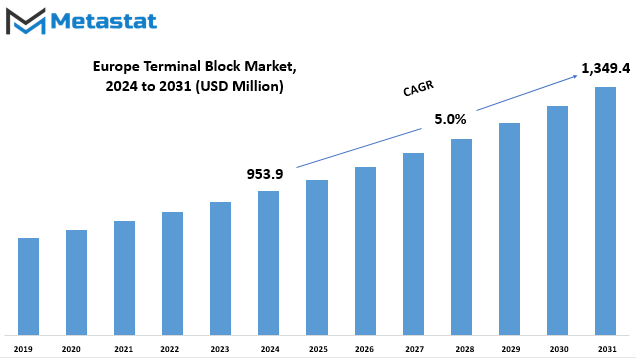
GROWTH FACTORS
The Europe Terminal Block market is witnessing significant growth, primarily fueled by the expanding realm of industrial automation and the escalating demand for efficient and reliable electrical connections. Simultaneously, the increasing adoption of renewable energy sources, such as solar and wind, is playing a pivotal role in driving the demand for terminal blocks in power generation and distribution.
However, the market faces challenges arising from intense competition, which exerts considerable pressure on prices and imposes margin constraints for manufacturers of terminal blocks. This competitive landscape has created a scenario where companies must navigate carefully to maintain profitability while meeting the evolving needs of the market.
Moreover, stringent regulatory requirements and compliance standards related to electrical safety pose additional challenges for product development and certification within the industry. Manufacturers find themselves grappling with the need to align with these regulations, impacting their ability to bring products to market efficiently.
Despite these challenges, there are promising opportunities on the horizon. The rising demand for electric vehicles (EVs) and the corresponding need for charging infrastructure present a significant avenue for growth in the terminal block market. Manufacturers can capitalize on this emerging trend by catering to the specific requirements of the growing EV market.
The Europe Terminal Block market is at a crossroads, balancing the positive momentum generated by factors like industrial automation and renewable energy adoption against the challenges posed by competition and regulatory demands. As the market continues to evolve, strategic adaptation to these dynamics will be essential for manufacturers to thrive in an environment marked by both hurdles and opportunities.
MARKET SEGMENTATION
By Type
In the realm of the Europe Terminal Block market, the categorization by type delves into various segments. These segments include Barriers or Barrier Strips, Sectional Terminal Blocks, PCB Mount Terminal Blocks, Power Terminal Blocks, and Others.
The market for terminal blocks, a crucial component in electrical connections, is diverse. Each type serves specific purposes, catering to the varied needs of electrical systems. Barriers or Barrier Strips act as protective shields, preventing unintended contact and ensuring the safety of electrical circuits. Sectional Terminal Blocks provide a modular approach, facilitating the organization of multiple connections. PCB Mount Terminal Blocks, designed for printed circuit boards, offer a space-efficient solution for electronic devices.
Power Terminal Blocks, another significant category, handle the transmission of higher voltages and currents. This type plays a vital role in power distribution, emphasizing durability and efficiency. The category Others encompasses a range of terminal block variations, contributing to the versatility of the market.
Understanding the nuances of each terminal block type is essential for professionals involved in electrical design and implementation. The market's segmentation enables users to pinpoint the specific terminal block that aligns with their application requirements.
The Europe Terminal Block market exhibits a diverse landscape, with each type playing a distinct role in the realm of electrical connections. The segmentation into Barriers or Barrier Strips, Sectional Terminal Blocks, PCB Mount Terminal Blocks, Power Terminal Blocks, and Others provides a comprehensive overview, aiding professionals in selecting the most suitable terminal block for their specific needs.
By Industry
The Europe Terminal Block market exhibits a diverse landscape with its segmentation based on various industries. These industries encompass Business Equipment, HVAC Systems, Power Supplies, Industrial Controls, Process Control Instruments, Telecom Equipment, Transportation, and Others.
In the terminal blocks, a crucial component in electrical connections, their applications span across Business Equipment, where they play a pivotal role in ensuring seamless electrical connections. Similarly, in HVAC Systems, terminal blocks contribute to the efficient functioning of heating, ventilation, and air conditioning units. Power Supplies rely on these blocks for secure and stable electrical connections, a fundamental requirement for their operations.
Moving on to Industrial Controls, terminal blocks are integral for maintaining precision and control in various industrial processes. Process Control Instruments utilize these components to ensure accuracy and reliability in their measurements and operations. Telecom Equipment, a sector dependent on swift and dependable communication, benefits from terminal blocks in establishing stable electrical connections for seamless communication networks.
Transportation, a sector encompassing diverse modes of conveyance, relies on terminal blocks to maintain the electrical integrity of various vehicles and systems. The term "Others" serves as a catch-all category, encapsulating additional industries where terminal blocks find applications, contributing to the overall versatility of these components.
The Europe Terminal Block market showcases a wide array of applications across different industries, underscoring the significance of these components in ensuring reliable and efficient electrical connections in diverse sectors. As businesses and technologies continue to evolve, the role of terminal blocks remains integral in sustaining the seamless flow of electrical power across various applications and industries.
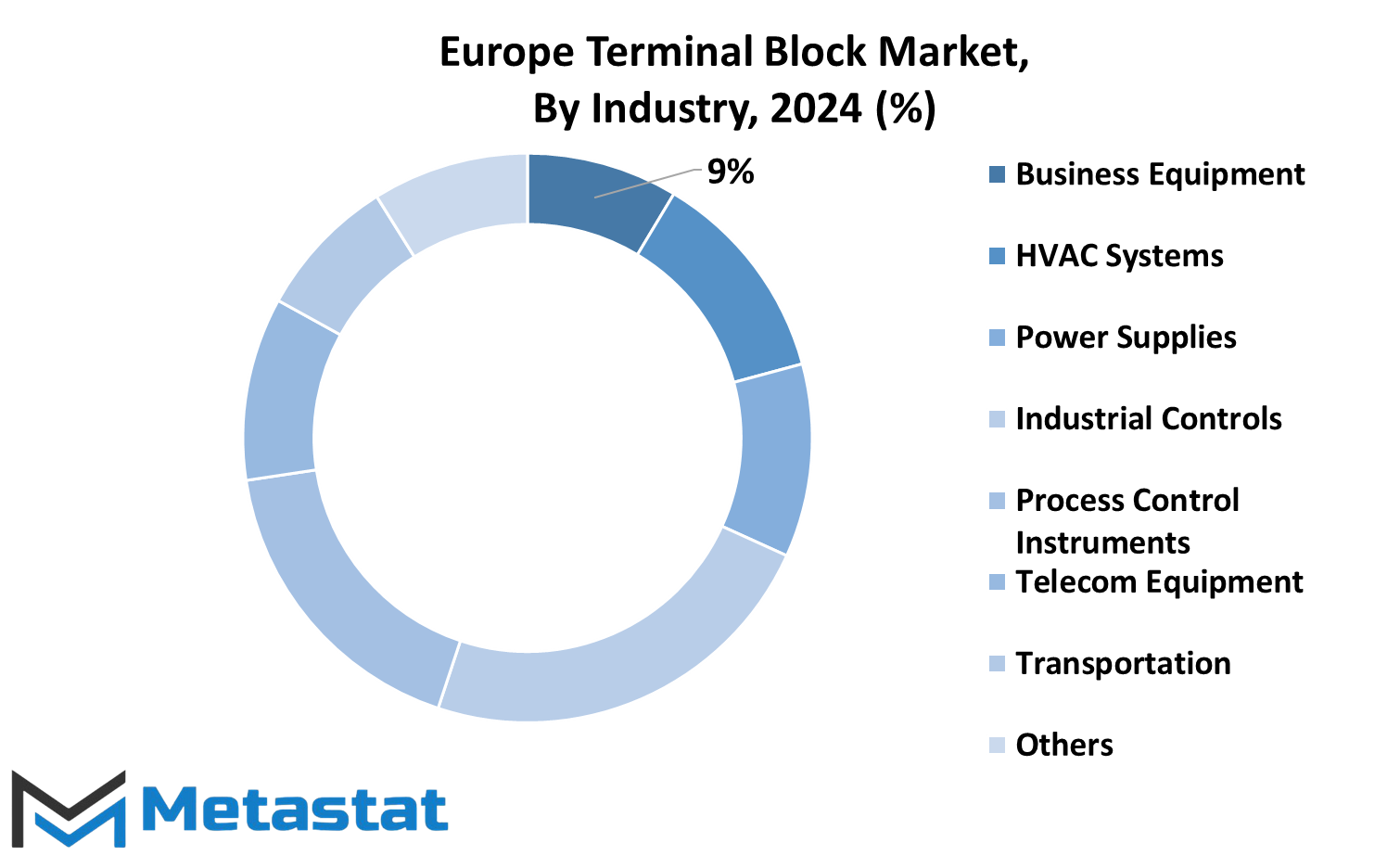
By Function Type
In the dynamic landscape of the European Terminal Block market, a detailed analysis reveals a diverse array of offerings, classified by their distinct functions. These functions play a pivotal role in shaping the market dynamics, catering to the varied needs of industries.
The market is categorized based on Function Type, with noteworthy subdivisions adding granularity to the understanding of terminal block applications. The primary divisions encompass Single-Level Feed-Through Terminal Blocks, Dual-Level Terminal Blocks, Three Level Blocks, Ground Circuit Terminals, Fuse Terminal Blocks, and Other Functions.
Single-Level Feed-Through Terminal Blocks form a foundational category, serving as straightforward connectors for electrical wiring. They facilitate the passage of a single wire through the block, ensuring a secure and efficient electrical connection. This simplicity in design aligns with the essential nature of many wiring setups.
Dual-Level Terminal Blocks introduce a layering aspect, accommodating multiple wires within the block structure. This design enhances efficiency by allowing the connection of several wires in a single terminal, catering to scenarios where space optimization is crucial. The dual-level configuration provides a practical solution without unnecessary complexities.
Three-Level Blocks take the concept of layering a step further, enabling the connection of three wires in a single terminal block. This intricate yet practical design addresses more intricate wiring setups, providing a versatile solution for industries with diverse connectivity requirements.
Ground Circuit Terminals serve a specialized purpose by ensuring a secure grounding connection. This function is indispensable in electrical systems, contributing to safety measures and the prevention of electrical hazards. The inclusion of such specialized terminal blocks reflects the market's responsiveness to industry-specific needs.
Fuse Terminal Blocks incorporate protective elements into the terminal block structure. This integration of fuses enhances the safety of electrical systems by preventing overloads and short circuits. Fuse terminal blocks exemplify the market's commitment to incorporating safety features seamlessly into its offerings.
Beyond these categories, the classification extends to encompass Other Functions, representing a broad spectrum of terminal block applications. This catch-all category acknowledges the continual innovation within the market, allowing for the incorporation of new and diverse functions that may not fit neatly into predefined classifications.
The European Terminal Block market, differentiated by its diverse functions, encapsulates a spectrum of solutions catering to the intricate demands of various industries. From the simplicity of Single-Level Feed-Through Terminal Blocks to the specialized safety features of Fuse Terminal Blocks, each category contributes to the market's adaptability and relevance in meeting the evolving needs of electrical connectivity.
REGIONAL ANALYSIS
Europe's Terminal Block market can be analyzed based on its geographical distribution. This regional analysis provides valuable insights into the market dynamics and trends within Europe. The geographical segmentation of the Europe Terminal Block market sheds light on how different regions contribute to the overall market landscape. It allows us to understand the variations in market conditions, preferences, and demands across different parts of Europe.
One significant aspect of the regional analysis is the identification of key market drivers and challenges specific to each geographic area. For instance, economic factors, regulatory environments, and local industry trends can significantly impact the performance of the Terminal Block market in a particular European region.
Moreover, the regional analysis provides a nuanced understanding of consumer behavior and preferences. It helps businesses tailor their strategies to meet the specific needs of customers in different parts of Europe. For instance, what works well in Western Europe might not necessarily be as effective in Eastern Europe due to variations in cultural, economic, or technological factors.
Furthermore, this analysis enables stakeholders to assess the competitive landscape at the regional level. Understanding the key players and market dynamics in each European region is crucial for businesses aiming to establish a strong market presence.
The regional analysis of the Europe Terminal Block market offers a comprehensive view of the market's dynamics across different geographic areas. It not only facilitates a better understanding of regional variations but also assists businesses in devising targeted strategies to thrive in diverse markets within Europe.
COMPETITIVE PLAYERS
In the dynamic landscape of the Europe Terminal Block market, various companies stand out as key players, each contributing to the industry's growth and competitiveness. ABB Ltd., Amphenol Communications Solutions, Eaton Corporation PLC, Dinkle International Co. Ltd., LEIPOLE ELECTRIC, Molex, LLC, Omron Corporation, Phoenix Contact GmbH & Co. KG, Rockwell Automation, Inc., Schneider Electric SE, Ningbo SUPU Electronics Co., Ltd, TE Connectivity Ltd., WAGO Kontakttechnik GmbH & Co. KG, Weidmüller Interface GmbH & Co. KG, Wieland Electric GmbH, and Würth Elektronik GmbH & Co. KG form the formidable lineup of competitive players.
Among these, ABB Ltd. showcases its expertise, contributing significantly to the terminal block sector. Amphenol Communications Solutions, with its proven track record, stands as a reliable player. Eaton Corporation PLC, with its strategic approach, has made noteworthy contributions, ensuring a competitive edge. Dinkle International Co. Ltd. brings innovation to the table, while LEIPOLE ELECTRIC emphasizes efficiency in its operations.
Molex, LLC, as a prominent player, adds diversity to the market, and Omron Corporation's commitment to quality is reflected in its market presence. Phoenix Contact GmbH & Co. KG, known for its robust solutions, plays a vital role in shaping industry standards. Rockwell Automation, Inc. contributes with technological advancements, and Schneider Electric SE is recognized for its sustainable practices.
Ningbo SUPU Electronics Co., Ltd, TE Connectivity Ltd., and WAGO Kontakttechnik GmbH & Co. KG bring their unique strengths, contributing to the overall competitiveness of the market. Weidmüller Interface GmbH & Co. KG, with its focus on innovation, complements the industry landscape. Wieland Electric GmbH stands out for its reliability, and Würth Elektronik GmbH & Co. KG's commitment to excellence further enriches the market dynamics.
The Terminal Block market in Europe is marked by the presence of these key players, each making distinctive contributions, collectively shaping the industry's trajectory. Their individual strengths and market presence underscore the competitiveness and dynamism inherent in the European Terminal Block market.
Terminal Block Market Key Segments:
By Type
- Barriers or Barrier Strips
- Sectional Terminal Blocks
- PCB Mount Terminal Blocks
- Power Terminal Blocks
- Others
By Industry
- Business Equipment
- HVAC Systems
- Power Supplies
- Industrial Controls
- Process Control Instruments
- Telecom Equipment
- Transportation
- Others
By Function Type
- Single-Level Feed-Through Terminal Blocks
- Dual-Level Terminal Blocks
- Three-Level Blocks
- Ground Circuit Terminals
- Fuse Terminal Blocks
- Other Functions
Key Europe Terminal Block Industry Players
- ABB Ltd.
- Amphenol Communications Solutions
- Eaton Corporation PLC
- Dinkle International Co. Ltd.
- LEIPOLE ELECTRIC
- Molex, LLC
- Omron Corporation
- Phoenix Contact GmbH & Co. KG
- Rockwell Automation, Inc.
- Schneider Electric SE
- Ningbo SUPU Electronics Co., Ltd
- TE Connectivity Ltd.
- WAGO Kontakttechnik GmbH & Co. KG
- Weidmüller Interface GmbH & Co. KG
- Wieland Electric GmbH
WHAT REPORT PROVIDES
- Full in-depth analysis of the parent Industry
- Important changes in market and its dynamics
- Segmentation details of the market
- Former, on-going, and projected market analysis in terms of volume and value
- Assessment of niche industry developments
- Market share analysis
- Key strategies of major players
- Emerging segments and regional growth potential



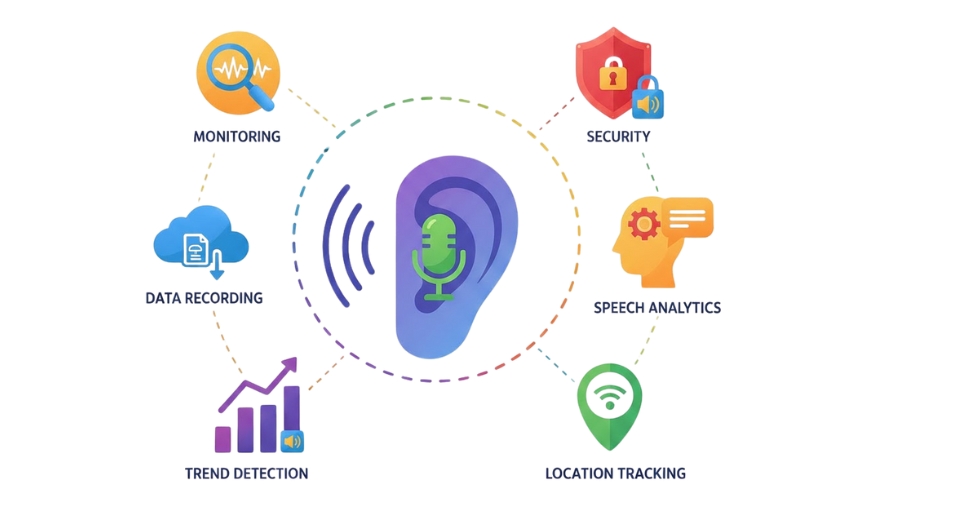
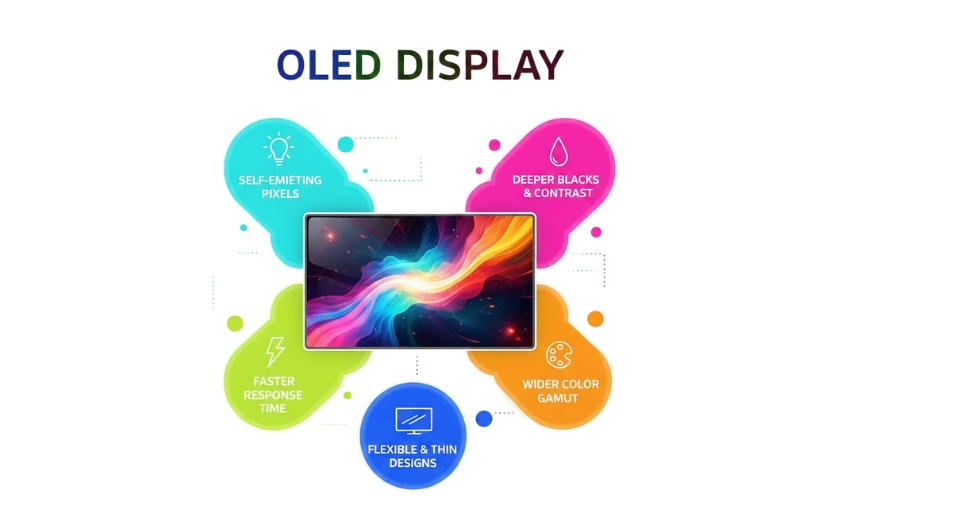
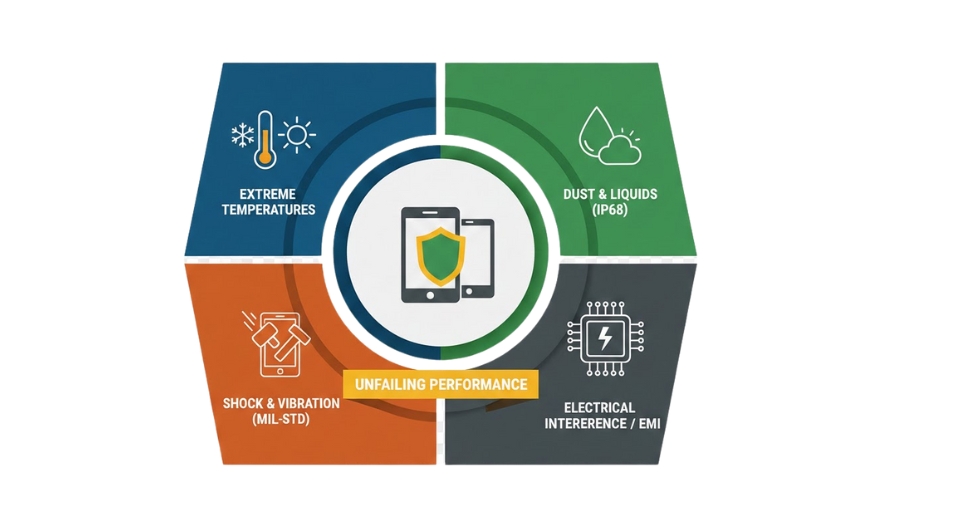


 US: +1 3023308252
US: +1 3023308252






